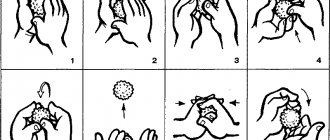Not all babies can master hissing and whistling sounds right away. Children even graduate from elementary school with some pronunciation features, and if this problem is left unattended, the speech defect will persist in adults. Even one sound pronounced incorrectly can trigger many speech therapy problems. Therefore, producing the sound “Ш” is an important task.
Formation of the sound "Ш".
Examination of the pronunciation of the sound “Ш”
When examining pronunciation, a specialist must find out how the sound being tested is pronounced separately, in words, in speech. For this purpose, images whose names include “Ш” can be used. It is important that it occupies different positions and combines with other sounds. The little student is asked to recite a poem in which the words have an "W".
If a child does not clearly pronounce an isolated “Sh”, you must first introduce this sound, and then consolidate its pronunciation in speech. If a child correctly pronounces a separate sound, but the defect is observed only in words, you need to work on consolidating it in speech.
Rules for testing at home:
- The child is in a calm state, repeating the necessary words after one of the parents. When forced into pronunciation, the sound is often distorted.
- The child pronounces the desired sound more than once. Sometimes children, even if they have a defect, can imitate the correct sound and the violation is not immediately noticed. It is easier to hear defective pronunciation in words where “Ш” is pronounced together with other consonants. To check, the child should pronounce the following words: chestnut, muffler, punch, mouthpiece.
For some children, the problem can be overcome in the first lessons; for others, the defect is dealt with step by step over some time, selecting appropriate tasks and techniques.
Exercises for making the sound “Ш”
The skills of correct pronunciation of sounds require not only regular practice. Parents are obliged to closely monitor the use of acquired skills in the process of daily communication of the child. It is necessary to correct mistakes and ask the child to repeat the problem word correctly. Parental speech also plays a huge role. Children are prone to imitation, so they need to hear the correct speech from others.
The first stage of practicing the pronunciation of a sound is its production. Training using the following exercises will help train your tongue to take the correct position:
- The movement of the “cup” is up and down.
- Exercise with a piece of cotton wool. It looks like a fun game, so children do it with great pleasure. The tongue takes the “cup” position. The baby needs to take it out of his mouth as far as possible. After this, a piece of cotton wool is placed on the nose. When you exhale, the air flow rushes upward, blowing away the cotton wool. This gymnastics is very effective for preventing lisp.
- "Boat on the Waves" The same “cup” plays the role of a boat, which is lifted up by the waves and, after a delay of three seconds, lowered down.
After the baby has begun to pronounce the sound “Ш” well, it is necessary to reinforce its pronunciation as often as possible. To do this, you need to use special tongue twisters, tongue twisters, nursery rhymes, and various materials.
Possible deviations
During the examination, it can be revealed that the sound “Ш” is pronounced incorrectly. Despite the fact that this sound is considered dull, it must be pronounced clearly and cleanly.
Possible deviations:
- The child sticks his tongue out too much between his teeth, resulting in a lisping sound.
- Sigmatism in “Ш” appears when there is strong tension in the deep part of the tongue. Then “W” is replaced by “X”.
- With lateral sigmatism, a “pop” is produced.
- Dental parasigmatism - the tongue rests on the upper incisors. Instead of "W" you get "T".
- With labiodental parasigmatism, “W” sounds like “F”.
- Instead of "SH" sounds "S", this is whistling parasigmatism.
It is important to tell your child how the speech organs should be positioned correctly. Classes should be accompanied by visual analogies and demonstrations.
Exercises for the development of the speech apparatus
When pronouncing the sound “sh” correctly, the tongue should occupy a certain position in the mouth. It is spread wide, and the tip is raised towards the hard palate, and forms a gap with it behind the upper teeth. The lateral edges of the tongue are pressed against the upper incisors.
How to teach a child to say the letter “sh” at home - do tongue exercises with him
If the baby cannot pronounce the sound correctly, articulation gymnastics is needed. For home exercises, special exercises are used that train the speech apparatus. The child should perform them in front of the mirror to see how he can repeat what his mother shows:
- “fence” - the baby must close his teeth and show his mother what kind of “fence” he has made;
- “tube” - the child stretches his lips forward like a tube, then quickly alternates between the “tube” and “fence” exercises;
- “lazy tongue” - the tongue needs to be stuck out of the mouth and placed on the lower lip, completely relaxed;
- “bucket” - we bend the relaxed tongue up and place it behind the upper teeth, blow on it, which produces the sound “sh”.
What to do to learn to pronounce “Sh”
Exercise for developing the sound “Ш”.
Correct pronunciation of the sound [w] is possible in this case: the teeth are as close as possible, the incisors are on top of each other, and the rounded lips are pushed forward, the tongue is shaped like a “bucket.”
Guidelines for parents
Sometimes parents do not turn to a speech therapist for various reasons. Some due to financial difficulties, others in accordance with their beliefs. At the same time, parents should know how to teach their child to say the letter “SH”.
Warm up for tongue and lips
The most effective and easy-to-implement way to cope with failure to pronounce sounds is articulatory gymnastics.
It includes the following exercises:
- “Let’s warm our palms.” His goal is to learn how to release a strong stream of air. The child needs to exhale air in even portions with rounded lips, without puffing out his cheeks.
- Naughty tongue. The exercise helps relax the tongue muscles. With the tongue placed on the lower lip, the syllable “five-five-five” is pronounced from 1 to 10, the edges of the tongue do not rise upward.
- Glue on some candy. The result of such training should be strengthened tongue muscles and a practiced upward movement of the tongue. The tip of the tongue is located on the lower lip, a small piece of toffee is placed on the edge, which must be glued to the palate. The jaw should remain motionless, only the tongue works.
- Swing. The tip of the tongue touches either the upper or lower teeth.
- Horse. Clack like a horse.
- Pancake. Place a relaxed tongue on the lower lip.
- Kitty. The child needs to reach his nose with his tongue.
- Focus. You need to open your mouth while smiling and place the edge of your tongue on your upper lip so that a groove is formed in the center; now you need to blow off the cotton wool that lies on your nose.
After warming up and practicing these exercises, you can begin direct sound production.
Exercises for the main stage
A basic exercise for articulating “W” can be using pronouncing “R” in front of a mirror in a whisper. At this time, you need to stop the vibration of the tongue with a spatula.
After completing the exercise with your mouth open, you can proceed to pronouncing the resulting sound, clenching your teeth. The normal sound of “Sh” is achieved by rounding the lips.
The basic one is also “T”, which is pronounced in front of the mirror. After which articulation is reproduced with a half-open mouth, while the front edge of the tongue should touch not the teeth, but the dental sockets. After which the “T” is pronounced at the holes with aspiration.
The child does not pronounce the sound [Ш]
A group of hissing sounds steadily enters speech by the age of four. Until this time, absence or distortion is considered a conditional norm. Parents may not always notice that something is wrong.
Classes can be conducted either with a speech therapist or at home
Pronunciation assessment
Pronunciation of any sound may be incorrect. In this case, the simplest option is the absence of the sound [Ш]. Then the child’s speech will sound something like this: apka, ina, maina, etc.
Sound distortion is more common. With buccal pronunciation, the air does not pass through the tongue and lips, but goes into the cheeks. The result is a dull noise at the output. You can visually see how the child’s cheeks are puffed up.
Sometimes a child can pronounce sibilants in the “down” position. In this case, it is not the tip of the tongue that approaches the hard palate, but the middle part of its back. In this case, you get something similar to [Ш].
If the baby manages to pronounce [Ш] the back part of the tongue, which approaches the hard palate. At the exit you can hear something resembling a fricative [X] or a voiced southern Russian [G].
Important! Only a speech therapist can accurately identify the violation.
When a child learns to speak, he can replace one sound with another. Often the hissing group is replaced by whistling ones - up to four years - this is the physiological norm.
If there are problems, the preschooler begins to change [W] to [S]. In this case, instead of “hat” he says “sapka”, instead of “machine” he says “masina”.
Physiological factors
A child can be easily talked into, but he does not always pronounce all the sounds correctly. With sibilants, problems can arise due to a shortened hyoid ligament.
Sometimes problems arise due to enlarged adenoids. In this case, the preschooler has breathing problems.
In severe cases, the child cannot breathe through his nose at all and opens his mouth slightly
A baby may pronounce sounds incorrectly due to minimal brain dysfunction. In this case, there are problems with raising the tip of the tongue, and switching from pose to pose is difficult.
When to contact a speech therapist
You can work with children at home in case of mild disorders. For example, if there are no problems with the dictionary and lexico-grammatical structure of speech. In this case, parents can perform articulation and breathing exercises.
The help of a speech therapist is required in case of general speech underdevelopment and dysarthria. With such violations, there are no quick ways to correct sound pronunciation.
It is easy to identify such problems. When first diagnosed, the child has a poor vocabulary; he may connect words incorrectly and have difficulty forming words.
We teach you to pronounce hissing sounds using the methods of Fomicheva and Bogomolova
With dysarthria, muscle innervation is disrupted. In this case, it is difficult for the preschooler to pronounce similar sounds, his breathing is weak and he has hypertonicity or hypotonicity of the muscles of the articulatory apparatus.
Important! For any problem, parents are direct participants in the correction process.
With dysarthria and general underdevelopment of speech, not only pedagogical help is needed, but also medical help.
Staging and subsequent automation of sound
By performing the exercises, they develop the correct articulation of “W”. But a skill is a mechanical process that takes time to practice and consolidate. A child can learn to pronounce “Ш” already in the first lessons, but in subsequent lessons the pronunciation turns into a lisp and whistling.
Speech games and tongue twisters starting with “Ш” will help automate sound:
- I can’t find our frog’s ears.
- Masha walked along the highway and sucked dryers.
Making the sound “Ш” by imitation.
You can come up with an interesting nickname for your favorite toy using “Sh”. For example, “Wolf-tail.”
Nursery rhymes will help you practice your speech.
You can ask your child to come up with a diminutive word. For example: winter - winter, spot - spot, mistress - hostess, uncle - uncle, grandfather - grandfather.
Causes of defects in the sound “Ш”
Only a specialist will determine the exact reason why a child cannot cope with the hissing sound. But in general, the following factors stand out:
- physiological . These include malocclusion, large tongue size, high palate and others;
- long-term use of the pacifier . Because of it, the bite deteriorates, which means that many sounds are susceptible to defects, especially hissing and whistling sounds;
- distortion of speech by parents . We often hear relatives “lisping” with the baby, pronouncing sounds in a distorted form. The baby very quickly grasps this manner of speaking, which can subsequently become fixed in speech;
- speech defects in adults . The baby often copies the speech of adults, which means that the defects of the parents can be passed on to the children;
- wrong approach to learning . Many mothers and fathers demand a lot from their children without trying to correctly demonstrate the ways of pronunciation and articulation of complex sounds;
- developmental delay . If a child’s thinking, memory and attention have not yet been formed, then speech will not be at the proper level;
- hearing impairment . A common cause of problems with “Sh” is when a child has difficulty recognizing sounds by ear.
If you notice that your child has been unable to pronounce the hissing sound “SH” for a long time, then you should not hesitate to visit a children’s speech therapist who can solve this problem professionally and efficiently.
Why doesn't the letter "Ш" hiss?
The reasons for incorrect pronunciation may be the following:
- Physiological: malocclusion, large tongue, high palate. In addition, the quality of the spoken sound depends on the development of the speech apparatus.
- Prolonged use of the pacifier. This item spoils the bite, which leads to distorted pronunciation of whistling and hissing sounds.
- "Lisping" with a child. By repeating after their elders, children distort their speech.
- Repeating incorrect pronunciation after adults who have speech impediments.
- Memory, thinking and attention are poorly developed.
- Speech hearing impairment (in some cases, dyslexia may develop).
If, after homework, the child still cannot pronounce the letter “SH,” you should contact a speech therapist.
How to check your pronunciation yourself
Typically, to identify a child’s speech problems, a speech therapist conducts a full examination. But, nevertheless, it is possible to check the baby’s speech at home. The check is carried out incrementally: syllables separately, then words, phrases and sentences.
To do this, it is necessary for the child to repeat the sounds after one of the parents. Using the same scheme, the pronunciation of syllables and other things is checked. To obtain more accurate information about how the child speaks, what he pronounces and what he cannot, it is necessary to put “SH” in various positions: OSHO, USHU, SHA, OSH, etc.
You should definitely remember that difficulties may arise with other sibilants or other consonants. If you decide to take on your child’s diction, then you need to be prepared for the fact that you may have to correct other sounds.
It is best to purchase or make special cards with various designs for testing. This will help give the process a gaming atmosphere. When choosing words to check, it is necessary that the letter be in different parts of the word. And when choosing sentences, it is desirable that there be words that are difficult to combine.
When to see a speech therapist
Distortion and replacement of sounds in three-year-old children is not considered a deviation. But if at 2 years old the child has no speech, then it is worth going to a consultation with a specialist. Only by the age of 5 does the formation of the phonetic series end. The setting of "Sh" occurs between the third and fifth years of life.
Violation of the pronunciation of “Ш” is correctable and is often eliminated relatively easily. The main thing is that classes are regular and systematic. It is important that the little student himself has the desire to correct his speech and pronounce “Sh” correctly.
The child and parents must show patience and perseverance during lessons. If the results are poor, then you should contact a speech therapist. A specialist can place “Ш” from the reference sound with mechanical assistance, using a probe or spatula.
What speech therapists advise
Not always, when a child does not pronounce “Sh,” parents can do without consulting a speech therapist. Sometimes, in addition to a speech therapist, it is recommended to visit a neurologist or orthodontist. This primarily applies to cases where the child has physiological or neurological abnormalities.
If the baby does not have any visible health problems, parents can work on improving his speech on their own by consulting a speech therapist or taking special parenting courses.
Experts recommend:
- conduct correction classes regularly and systematically;
- do not overload the child and do not demand instant results;
- introduce a gaming element into classes;
- be sure to conduct physical exercises during classes;
- maintain composure and friendliness;
- give your child praise even for the smallest achievements;
- approach work systematically, gradually complicating tasks as you achieve success at the previous level;
- You should not start learning foreign languages with your child before he learns to correctly pronounce the sounds of his native speech.
Hissing sounds cause difficulty for many preschoolers. With timely identification of the problem and a responsible approach, parents will be able to rid the child of them, prevent it from worsening, and prevent problems with the child’s socialization in the future.
Sibilants in a child's speech
Hissing ones include - [w], [zh], [h`], [sch`]. The formation of their correct pronunciation occurs between the third and fifth years of the baby’s life.
Incorrect pronunciation of “Sh”: types, reasons
Distortion or complete absence of sibilants in a child’s speech is called sigmatism. Depending on the type of incorrect placement, there are 4 types of sigmatism:
- Parasigmatism is a stable replacement of [sh] with another sound. Labial-dental - dental - replacement of [w] with [f]. Prizubny - replacing [w] with [t]. Hissing - replacing [w] with [sch]. Whistling - replacing [w] with [s] or [z]. Occurs with malocclusion or impaired phonemic hearing. Example: hat - slipper.
- Interdental sigmatism is the same “lisping” sound. Occurs due to a shortened frenulum or narrow soft palate.
Lesson with a specialist
- Lateral sigmatism - the sound [w] does not sound firm, as it should, but squelching, as if the baby had taken water into his mouth. Observed due to lateral open bite or weak tongue muscles.
- Nasal sigmatism - in a preschooler, the back of the tongue becomes very tense, and [w] can be pronounced with a nasal “echo.”
Before figuring out how to teach a child to pronounce the letter w, you should understand the reasons for the violation. Often a routine visit to the orthodontist, during which the bite or upper palate is corrected, ends with the long-awaited “hissing” of the baby. Otherwise, there is a need to develop the correct articulation pattern in speech therapy classes.
Articulation gymnastics for staging hissing
Before requiring the baby to pronounce a hissing sound, it is necessary to carry out preparatory articulatory gymnastics. Its duration is no more than 10 minutes. Despite the fast pace (so that the preschooler does not get bored), the child must perform each exercise carefully, since gymnastics directly determines how quickly a child can learn to say the sound [w].
Main tasks in articulatory gymnastics:
- Fence - a wide smile with teeth.
- Tube - the lips are gathered into a tube, there is a small gap between the lips.
- Alternating fence - tube.
- Hippopotamus - open your mouth wide and hold it for a while.
- Spatula - place a wide, outstretched tongue on the lower lip. You can “bite” with your tongue to make it wider.
- Homemade jam: lick the upper and then the lower lip with the tip of your tongue.
- Brush - move the tip of your tongue across the soft palate - from the throat to the teeth and back.
Articulation gymnastics
Tasks to determine the position of a sound in a word
At the beginning of the lesson, you can also develop phonemic awareness - determine the position of a sound in a word. To do this, you will need rich verbal and subject material.
- The child is asked to clap if he hears the “snake song (sound [sh]).” In this case, words are pronounced that contain the desired sound or do not contain them. You should not pronounce words with other hissing or mixed whistling sounds.
- The child is given a small sign with 3 windows indicating the beginning, middle and end of the word. And also a chip (cube/drawn sound). The teacher says the condition: “I will name the word, and you put the chip where the sound [w] is located.”
Open lesson on speech development in the second junior group
Gymnastics for clear pronunciation
To correctly pronounce hissing sounds, speech therapy uses articulation and breathing exercises in combination. In this case, you should definitely remember about the correct position of the organs of articulation: lips and tongue.
Additional Information! Breathing exercises are aimed at developing smooth exhalation. To teach your child to perform breathing exercises, you need to create bright and interesting didactic material. For example, a flower with a butterfly sitting on it, which, according to the terms of the task, needs to be blown away.
Methodological basics for parents
It is important to know the correct position of the tongue and lips when pronouncing a sound in order to work on the exercises at home.
- Lips in the “tube” position;
- The tongue is wide, the tip is raised upward;
- The lateral parts of the tongue are in contact with the teeth of the upper jaw;
- A small gap forms between the palate and the tongue in the area of the upper incisors.
“Home” speech therapy sound [w]
To teach your child to pronounce [w] correctly at home, you need to learn several basic methods of production:
- mechanical;
- from a similar-sounding sound.
Mechanical setting
With this method, the baby does not need to independently search for the correct position of the sound - an adult does this for him, using special speech therapy tools (spatula, probe). If you need to put your hand into a preschooler’s mouth, it must be clean.
Mechanical staging process
Staging through sound [r]
How to learn to say the letter Ш through the sound [r]? It would seem that incorrect pronunciation of [r] is the most complex and most common speech defect. However, many children know how to pronounce [r] correctly, but do not understand at all how to position the tongue in the mouth in order to whistle and hiss correctly. For this reason, the sound should be produced through a solid [r], and not adjacent sibilants.
The preschooler should sit in front of the mirror and pronounce [r], gradually weakening the air pressure. The sound should be pronounced until the vibration completely disappears. After this, a slight hiss will be heard and [w] will sound without the auxiliary [r].
Speech therapy exercises on pronunciation of the sound [sh]
To consolidate the placed [w] in the baby’s speech, it is necessary to speak as much as possible with a separate sound - hiss during the game. For this, the preschooler is offered various exercises:
- move the snake along the path, and hiss at the same time;
- “finish” a word, for example - small ..(sh), karanda ..(sh), etc.
Speech per year











